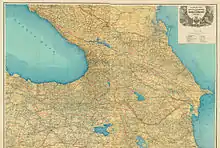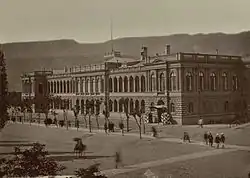Caucasus Viceroyalty (1801–1917)
The Caucasus Viceroyalty was Imperial Russia's administrative and political authority in the Caucasus region exercised through the offices of glavnoupravlyayushchiy (Russian: главноуправляющий) (1801–1844, 1882–1902) and namestnik (наместник) (1844–1882, 1904–1917). These two terms are commonly, but imprecisely, translated into English as viceroy, which is frequently used interchangeably with governor general. More accurately, glavnoupravljajuščij is referred to as High Commissioner of the Caucasus, and namestnik as Viceroy.
| Caucasus Viceroyalty Кавказское наместничество | |||||||||||
|---|---|---|---|---|---|---|---|---|---|---|---|
| Viceroyalty of the Russian Empire | |||||||||||
| 1801–1917 | |||||||||||
 | |||||||||||
 | |||||||||||
| Capital | Tiflis | ||||||||||
| History | |||||||||||
• Established | 1801 | ||||||||||
• Disestablished | 1917 | ||||||||||
| |||||||||||
Over more than a century of the Russian rule of the Caucasus, the structure of the viceroyalty underwent a number of changes, with the addition or removal of administrative positions and redrawing of provincial divisions.[1]
History
The first time Russian authority was established over the peoples of the Caucasus was after the Russian annexation of the Kingdom of Kartli-Kakheti (eastern Georgia) in 1801. General Karl von Knorring was the first person to be assigned to govern the Caucasus territory, being officially titled as the Commander-in-Chief in Georgia and Governor General of Tiflis (Tbilisi). Under of his successors, notably Prince Pavel Tsitsianov, General Aleksey Yermolov, Count Ivan Paskevich, and Prince Mikhail Vorontsov, Russian Transcaucasia expanded to encompass territories acquired in a series of wars with the Ottoman Empire, the Persian Empire, and local North Caucasian peoples. The scope of its jurisdiction eventually came to include what is now Georgia, Armenia, Azerbaijan, and the North Caucasus, as well as parts of Northeastern Turkey (today the provinces of Artvin, Ardahan, Kars, and Iğdır).[2]
Headquartered at Tiflis, the viceroys acted as de facto ambassadors to neighboring countries, commanders in chief of the armed forces, and the supreme civil authority, mostly responsible only to the tsar. From February 3, 1845, to January 23, 1882, the viceregal authority was supervised by the Caucasus Committee, which consisted of representatives of the State Council and the ministries of Finances, State Domains, Justice, and Interior, as well as of members of special committees. After the 1917 February Revolution, which dispossessed Tsar Nicholas II of the Russian crown, the Viceroyalty of the Caucasus was abolished by the Russian Provisional Government on March 18, 1917, and all authority, except in the zone of the active army, was entrusted to the civil administrative body called the Special Transcaucasian Committee or Ozakom (short for Osobyy Zakavkazskiy Komitet, Особый Закавказский Комитет).
..jpg.webp)
Governorates and Oblasts in 1917

High Commissioners and Viceroys of the Caucasus
- Karl Heinrich von Knorring 1801–1802
- Pavel Tsitsianov 1802–1806
- Ivan Gudovich 1806–1809
- Alexander Tormasov 1809–1811
- Philip Paulucci 1811–1812
- Nikolay Rtishchev 1812–1816
- Aleksey Yermolov 1816–1827
- Ivan Paskevich 1827–1831
- Gregor von Rosen 1831–1838
- Yevgeny Golovin 1838–1842
- Aleksandr Neidgardt 1842–1844
- Mikhail Vorontsov 1844–1854
- Nikolay Muravyov-Amursky 1854–1856
- Aleksandr Baryatinsky 1856–1862
- Grigol Orbeliani (acting) 1862
- Grand Duke Mikhail Nikolayevich 1862–1882
- Aleksandr Dondukov-Korsakov 1882–1890
- Sergei Sheremetyev 1890–1896
- Grigory Golitsyn 1896–1904
- Yakov Malama (acting) 1904
- Illarion Vorontsov-Dashkov 1904–1916
- Grand Duke Nikolay Nikolayevich 1916–1917
References
- (in Armenian) Hambaryan, Azat S. (1981). "Հայաստանի սոցիալ-տնտեսական և քաղաքական դրությունը 1870-1900 թթ." [Armenia's social-economic and political situation, 1870–1900] in Hay Zhoghovrdi Patmut'yun [History of the Armenian People], ed. Tsatur Aghayan et al. Yerevan: Armenian Academy of Sciences, vol. 6, pp. 15–17.
- Tsutsiev, Arthur (2014). Atlas of the Ethno-Political History of the Caucasus. Translated by Nora Seligman Favorov. New Haven: Yale University Press. p. 37. ISBN 9780300153088.
Further reading
- Atkin, Muriel (1980). Russia and Iran, 1780–1828. Minneapolis: University of Minnesota Press. ISBN 978-0816609246.
- Baddeley, John F. (1908). The Russian Conquest of the Caucasus. London: Longmans, Green and Co.
- Breyfogle, Nicholas (2005). Heretics and Colonizers: Forging Russia's Empire in the South Caucasus. Ithaca: Cornell University Press. ISBN 978-0801442421.
- Haxthausen, Baron August von (2016) [1854-55]. Transcaucasia and the Tribes of the Caucasus. Translated by John Edward Taylor. Introduction by Pietro A. Shakarian. Foreword by Dominic Lieven. London: Gomidas Institute. ISBN 978-1909382312.
- Jersild, Austin (2003). Orientalism and Empire: North Caucasus Mountain Peoples and the Georgian Frontier, 1845-1917. Montreal and Kingston: McGill-Queen's University Press. ISBN 978-0773523296.
- King, Charles (2008). The Ghost of Freedom: A History of the Caucasus. Oxford: Oxford University Press. ISBN 978-0195177756.
- Layton, Susan (1995). Russian Literature and Empire: Conquest of the Caucasus from Pushkin to Tolstoy. Cambridge: Cambridge University Press. ISBN 978-0521444439.
- Tsutsiev, Arthur (2014). Atlas of the Ethno-Political History of the Caucasus. Translated by Nora Seligman Favorov. New Haven: Yale University Press. ISBN 978-0300153088.
See also
- Caucasus Viceroyalty (1785–96)
- Caucasus Viceroyalty (1801–1917) topics
- Viceroyalties of the Russian Empire